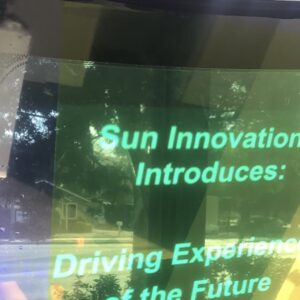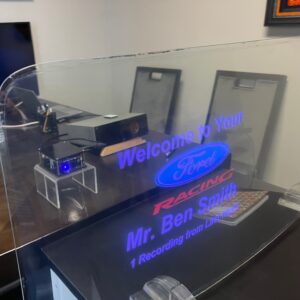Vehicle Media Glass
MediaGlass is a transparent display solution, turning clear panels such as glass and acrylic screens into digital displays with a patented film that absorbs light projected at it, re-emitting the light at a different wavelength. As the emission occurs within the film, the display is equally vivid on both sides of the film, so it works for both front and rear projection. MediaGlass has won awards and stunned engineers worldwide with its novelty. Time and again viewers wave their hand through the faintly-visible blu ray projected light, asking what magic is embedded in the film, how do dim purple monochrome ripples get transformed into a brilliant full color display?
Through years of research on nanoparticles, Sun Innovations, Inc. has created combinations of particles which transform and re-emit the light, allowing for first monochrome and then full color, RGB displays. Monochrome is more economical given the projector need only handle one wavelength of light, while vivid full color is available as in the sample shown. As the core technology is in the film itself, multiple projector types can be used: Gobo for static image rotation, laser for vector images, and wifi-networkable DLP for normal raster graphics such as one would use in DOOH in store-advertising.
Applications are far-ranging for transparent displays, from in-store advertising and sneeze-guard displays to displaying information and video on panels in banks, airports, sports stadiums, medical offices, and other facilities with clear partitions. It’s so high tech, it looks like magic and breathes excitement into customer engagement, in-store advertising, institutional messaging, DOOH, and other applications.
MediaGlass has a more transparent display than transparent OLED, at a substantially more economical cost. Another point of advantage is that since MediaGlass is fundamentally a projection lighting solution, it’s more scalable to small or large size than transparent OLED, making it easy to adapt to different application or installation requirements.
Competing transparent film display technologies use a cloudy film which scatters part of the visible, projected light, while the rest of the light goes through the film. Sun Innovations emissive film is 99% optically clear, not using cloudy light-scattering particles to catch part of the projected light. Only MediaGlass film changes the wavelength of all the projected light from invisible to visible, converting all the projected light so the film lights up and none of the projected light passes through the film. This makes it much more professional-looking, and leaves viewers delighted and amazed.
Showing all 5 results





